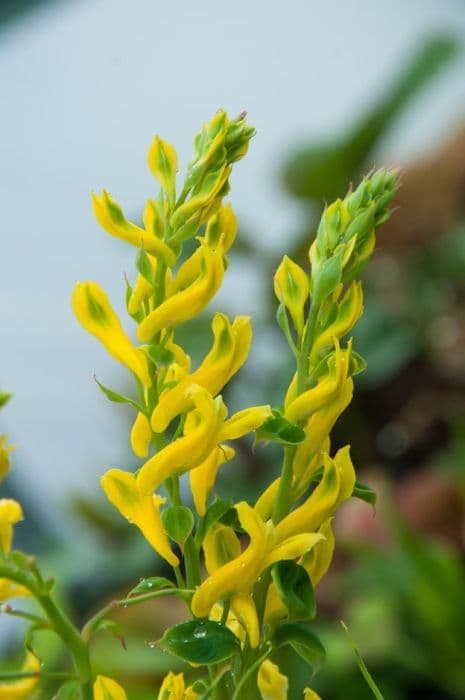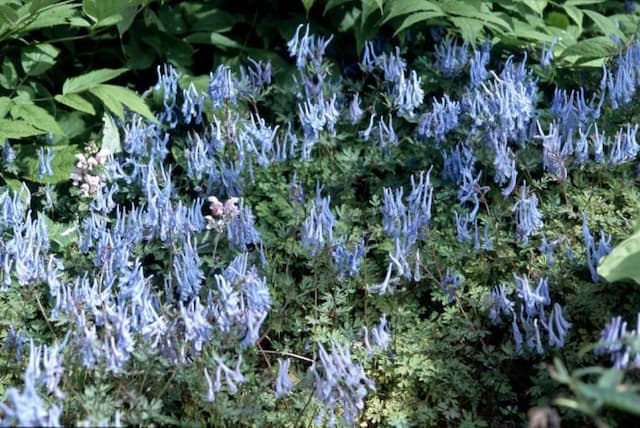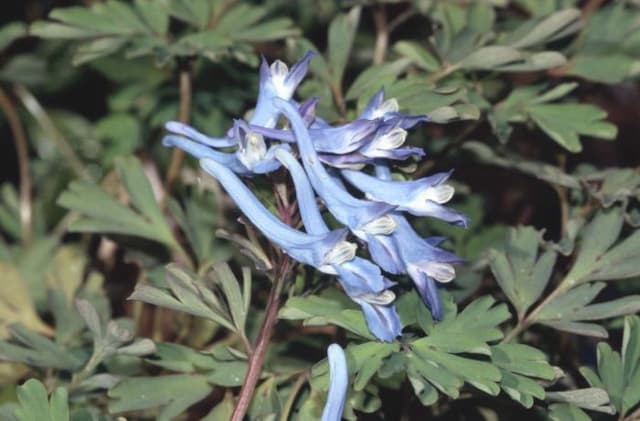Spanish poppy Papaver rupifragum

ABOUT
The plant commonly known as Spanish poppy is an attractive perennial that features a bushy, clumping habit with narrow, green to blue-green foliage that extends from its base in a tufted manner. The leaves are somewhat lance-shaped, with a delicate and slightly hairy texture. Spanish poppy blooms in warmer seasons, and its flowers are the most striking aspect of its appearance. The blooms of the Spanish poppy are orange to vibrant apricot in color and exhibit a satiny sheen. Each flower is composed of four delicate, overlapping petals forming a bowl-like shape with a dark basal blotch at the base, giving the flowers a distinctive look. At the center of the flower, there is a prominent cluster of dark stamens which adds to the visual appeal of the bloom. While the plant's size is not to be detailed, it's essential to note that it has a proportionate stature that accommodates its floral display. The Spanish poppy's flowers rise above the foliage on thin, wiry stems that sway gracefully with the wind, emphasizing the lightness and dainty structure of the plant. This arrangement allows the flowers to stand out and catch the eye of onlookers and pollinators alike. Overall, the Spanish poppy's appearance is characterized by its graceful stems, vibrant blooms, and fine foliage, creating an air of elegance and charm in any garden setting where it is planted.
About this plant
 Names
NamesFamily
Papaveraceae
Synonyms
Spanish Poppy, Atlas Poppy, Moroccan Poppy
Common names
Papaver rupifragum var. atlanticum, Papaver atlanticum.
 Toxicity
ToxicityTo humans
Papaver rupifragum, commonly known as the Spanish poppy, is not typically considered a highly toxic plant to humans. However, it belongs to the Papaveraceae family, which includes some species that contain compounds that can be harmful if ingested in large quantities. The Spanish poppy itself is not commonly associated with significant toxicity, and there is limited information on its specific effects. However, ingestion of poppy family plants can potentially lead to symptoms such as gastrointestinal upset, sedation, or respiratory depression in significant doses. As with many plants, individual sensitivity may vary, so it is advisable to avoid ingesting this plant.
To pets
Papaver rupifragum, known as the Spanish poppy, has a similar level of toxicity to pets as it does to humans. It is a member of the Papaveraceae family, which contains species with potentially harmful alkaloids. The Spanish poppy is not usually recognized for severe toxicity, but the ingestion of plants in this family by pets can cause mild to moderate symptoms, such as gastrointestinal upset, drooling, loss of appetite, or sedation. More serious effects such as respiratory depression could occur with the ingestion of larger quantities. It is always prudent to prevent pets from consuming plants, particularly those that are suspected to contain toxic substances.
 Characteristics
CharacteristicsLife cycle
Perennials
Foliage type
Semi-deciduous
Color of leaves
Green
Flower color
Orange
Height
1-2 feet (30-60 cm)
Spread
1 foot (30 cm)
Plant type
Herb
Hardiness zones
8
Native area
Southwest Europe
Benefits
 General Benefits
General Benefits- Ornamental Appeal: Papaver rupifragum, commonly known as Spanish poppy, adds beauty to gardens with its vibrant orange flowers.
- Drought Tolerance: It is well-suited to dry climates and poor soils, requiring minimal water once established.
- Attracts Pollinators: The flowers attract bees and butterflies, which are beneficial for the pollination of nearby plants.
- Low Maintenance: Spanish poppy is known for being easy to care for, not requiring much attention beyond the initial planting.
- Seasonal Interest: It provides seasonal color and interest in a garden landscape, particularly in the late spring and summer when it blooms.
- Self-seeding: Spanish poppy can self-seed, ensuring that once you plant it, it can propagate itself naturally in your garden.
 Medical Properties
Medical PropertiesThis plant is not used for medical purposes.
 Air-purifying Qualities
Air-purifying QualitiesThis plant is not specifically known for air purifying qualities.
 Other Uses
Other Uses- Papaver rupifragum, also known as Spanish poppy, can be used as a natural fabric dye, providing a subtle color to textiles.
- The petals of the Spanish poppy can be incorporated into potpourri mixtures for their color and delicate structure.
- Spanish poppy seed pods can be used in floral arrangements to add an interesting shape and texture.
- The seeds of the Spanish poppy can be used in bird feed mixes to provide a nutritious snack for wild birds.
- Spanish poppies can be planted as part of a butterfly garden to attract and provide nectar for various butterfly species.
- The plant's dried stalks and foliage can be used in crafting, such as making decorative wreaths or as filler in dried bouquets.
- Spanish poppy can be used in educational settings, such as school gardens, to teach about plant life cycles and pollination.
- The bright flowers of the Spanish poppy can be used as a natural indicator of soil health, blooming vividly when the soil is fertile.
- Illustrators and botanical artists may use Spanish poppies as a subject for their artwork, capturing their intricate details.
- Gardeners can use Spanish poppies for companion planting, as they may help deter certain pests when intercropped with vegetables.
Interesting Facts
 Feng Shui
Feng ShuiThe Spanish poppy is not used in Feng Shui practice.
 Zodiac Sign Compitability
Zodiac Sign CompitabilityThe Spanish poppy is not used in astrology practice.
 Plant Symbolism
Plant Symbolism- Peace - Papaver rupifragum, commonly known as the Spanish Poppy, is often associated with peace due to the common symbolism of poppies after World War I, representing the end of warfare.
- Remembrance - Similar to the red poppies worn for Remembrance Day, Spanish Poppies can symbolize memory and commemoration of soldiers who have died in wars.
- Sleep and Rest - Due to the opiate properties traditionally associated with some poppies, the Spanish Poppy might symbolize sleep, rest, and oblivion.
- Beauty and Resilience - Poppies, in general, can be seen as symbols of beauty and resilience as they have the ability to grow in difficult conditions and still offer vivid blooms.
- Consolation - In some cultures, poppies can also be a symbol of consolation for loss and suffering, perhaps due to their link with remembrance and the soothing qualities of their derivatives.
 Water
WaterThe Spanish poppy should be watered sparingly, as it is drought tolerant and prefers well-drained soil. During the growing season, watering once every 1-2 weeks with about one to two gallons per square yard should suffice, depending on the weather. Be sure to allow the soil to dry out between waterings. Over the winter months, reduce watering significantly, only providing enough to prevent the soil from completely drying out, as this plant is quite hardy and too much moisture can lead to root rot.
 Light
LightThe Spanish poppy thrives best in full sunlight, so it should be planted in a spot where it can receive at least 6 to 8 hours of direct sunlight daily. A south-facing garden bed or a location that is not shaded by larger plants or buildings would be ideal. However, in extremely hot climates, some afternoon shade can be beneficial to prevent scorching.
 Temperature
TemperatureThe Spanish poppy can withstand a wide range of temperatures but grows best when daytime temperatures are between 60°F and 75°F. It is quite hardy and can survive minimum temperatures down to 20°F, while maximum temperatures should not exceed 100°F for extended periods to avoid heat stress on the plant.
 Pruning
PruningPruning the Spanish poppy is generally done to remove spent flowers and encourage a second flush of blooms. Deadhead the plant by cutting back the stem below the faded flower. Pruning can be done throughout the flowering season as needed. The best time to prune for overall plant shape and health is in the late fall or early spring before new growth begins.
 Cleaning
CleaningAs needed
 Soil
SoilSpanish Poppy prefers a well-draining soil mix with sharp sand or gravel for good drainage, slightly alkaline to neutral in pH, ranging from 6.5 to 7.5.
 Repotting
RepottingSpanish Poppy does not require frequent repotting and it's best left undisturbed; repot only if necessary, approximately every 2-3 years.
 Humidity & Misting
Humidity & MistingSpanish Poppy thrives in average humidity conditions; no special humidity adjustments are needed for this plant.
 Suitable locations
Suitable locationsIndoor
Place in bright light, well-draining soil, minimal watering for Spanish Poppy.
Outdoor
Full sun, well-drained soil, protect from strong winds for Spanish Poppy.
Hardiness zone
5-9 USDA
 Life cycle
Life cyclePapaver rupifragum, commonly known as the Spanish poppy, begins its life cycle as a seed, typically sown in the fall or early spring directly into the soil. Upon germination, which requires a period of cold stratification, the seed develops into a small seedling with a rosette of basal leaves. As the plant matures, it forms a sturdy stem and feathery, blue-green foliage. Flower buds form and blossoms unfold into vibrant orange-red poppies by late spring to early summer. After pollination by insects, the flowers produce seed pods that mature, dry out, and release seeds for the next generation. The Spanish poppy is a perennial plant, completing this cycle yearly and may go dormant in hot summers or propagate through self-seeding.
 Propogation
PropogationPropogation time
Spring to summer
The most common method of propagating the Spanish Poppy, or Papaver rupifragum, is by sowing seeds. The best time to propagate by seeds is in spring or autumn. To do so, you should scatter the seeds thinly over well-drained soil in a sunny to a partially shaded location. Cover the seeds very lightly with soil as they require some light to germinate. Keep the soil moist but not waterlogged. Seedlings will emerge in 14 to 28 days, at which point you should ensure they are spaced adequately to prevent overcrowding. Transplanting can occur when the seedlings are large enough to handle.









